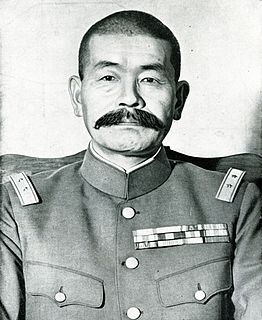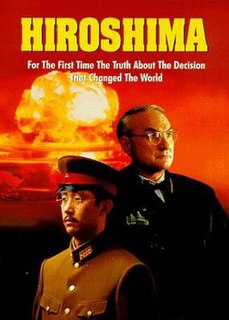This article includes a list of references, related reading or external links, but its sources remain unclear because it lacks inline citations .(February 2013) (Learn how and when to remove this template message) |
Lt. Col. Masahiko Takeshita(竹下正彦Takeshita Masahiko) was the head of the domestic affairs section of the Military Affairs Bureau of the Imperial Japanese Army during World War II. In August 1945, he helped plan a coup , the Kyūjō incident, along with Major Kenji Hatanaka and a handful of others.[ who? ] The intent of the attempted coup was to prevent the Emperor's announcement of Japan's surrender from being broadcast.

The Imperial Japanese Army was the official ground-based armed force of the Empire of Japan from 1868 to 1945. It was controlled by the Imperial Japanese Army General Staff Office and the Ministry of the Army, both of which were nominally subordinate to the Emperor of Japan as supreme commander of the army and the navy. Later an Inspectorate General of Aviation became the third agency with oversight of the army. During wartime or national emergencies, the nominal command functions of the emperor would be centralized in an Imperial General Headquarters (IGHQ), an ad-hoc body consisting of the chief and vice chief of the Army General Staff, the Minister of the Army, the chief and vice chief of the Naval General Staff, the Inspector General of Aviation, and the Inspector General of Military Training.

World War II, also known as the Second World War, was a global war that lasted from 1939 to 1945. The vast majority of the world's countries—including all the great powers—eventually formed two opposing military alliances: the Allies and the Axis. A state of total war emerged, directly involving more than 100 million people from over 30 countries. The major participants threw their entire economic, industrial, and scientific capabilities behind the war effort, blurring the distinction between civilian and military resources. World War II was the deadliest conflict in human history, marked by 50 to 85 million fatalities, most of whom were civilians in the Soviet Union and China. It included massacres, the genocide of the Holocaust, strategic bombing, premeditated death from starvation and disease, and the only use of nuclear weapons in war.
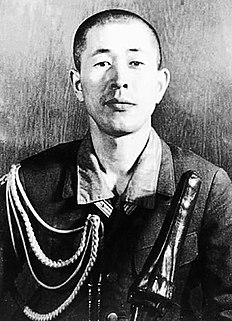
The Kyūjō incident was an attempted military coup d'état in the Empire of Japan at the end of the Second World War. It happened on the night of 14–15 August 1945, just before the announcement of Japan's surrender to the Allies. The coup was attempted by the Staff Office of the Ministry of War of Japan and many from the Imperial Guard to stop the move to surrender.
As one of the most senior officers involved in the coup, he was, at times, the leader of the group. He believed, as did his co-conspirators and many others, that the Emperor had to be separated from his peace-seeking advisors and convinced to change his mind. They believed that the costs of repelling an Allied land invasion would not be devastating, and that, ultimately, Japan would be better off under military rule, with his brother-in-law, Minister of War Korechika Anami as shōgun .
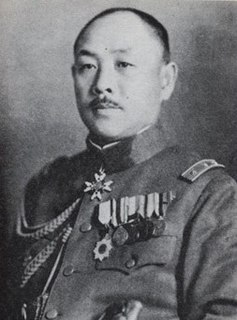
Korechika Anami was a general in the Imperial Japanese Army during World War II, and was War Minister at the time of the surrender of Japan.

The Shōgun was the military dictator of Japan during the period from 1185 to 1868. The shogunate was their administration or government. In most of this period, the shōguns were the de facto rulers of the country, although nominally they were appointed by the Emperor as a ceremonial formality. The shōguns held almost absolute power over territories through military means. Nevertheless, an unusual situation occurred in the Kamakura period (1199–1333) upon the death of the first shōgun, whereby the Hōjō clan's hereditary titles of shikken (1199–1256) and tokusō (1256–1333) dominated the shogunate as dictatorial positions, collectively known as the Regent Rule (執権政治). The shōguns during this 134-year period met the same fate as the Emperor and were reduced to figurehead status until a coup d'état in 1333, when the shōgun was restored to power in the name of the Emperor.
Takeshita had a close relationship with Anami, and was among the few who had the Minister's ear; Anami considered Takeshita one of his closest confidants, and so it was through him that the rebels gained much of their information and influence. Ultimately, however, Anami insisted that while he was sympathetic with the rebels' cause, he could not actively oppose the wishes of the Emperor. Despite being so trusted by the Minister, he was at times confused as to Anami's true desires regarding the coup.
In the afternoon on August 14, Anami officially announced to the conspirators that the Cabinet had decided to terminate the war. The Cabinet operated by unanimous decision, and so this meant that Anami had given in. Faced with the now fully official opposition of the Cabinet, and the final loss of any aid Anami might have provided, Takeshita withdrew from the plot along with Col. Okikatsu Arao.
Colonel Okikatsu (Koko) Arao was one of the original plotters in a scheme to prevent the Emperor's declaration of surrender at the end of World War II. He was the chief of the War Affairs section of the Military Affairs Bureau of the Imperial Japanese Army.
Early on the morning of August 15, 1945, Major Hatanaka spoke with Takeshita, trying one last time to convince him to rejoin the rebellion, and to secure the aid of General Anami. Takeshita refused, and realized, given the circumstances, that Anami would probably try to commit suicide. He traveled to the General's house, and acted as kaishakunin , second, in his brother-in-law's act of seppuku .

A kaishakunin is an appointed second whose duty is to behead one who has performed seppuku, Japanese ritual suicide, at the moment of agony. The role played by the kaishakunin is called kaishaku.

Seppuku, sometimes referred to as harakiri, is a form of Japanese ritual suicide by disembowelment. It was originally reserved for samurai, but was also practiced by other Japanese people later on to restore honor for themselves or for their families. A samurai practice, seppuku was used either voluntarily by samurai to die with honor rather than fall into the hands of their enemies, as a form of capital punishment for samurai who had committed serious offenses, or performed because they had brought shame to themselves. The ceremonial disembowelment, which is usually part of a more elaborate ritual and performed in front of spectators, consists of plunging a short blade, traditionally a tantō, into the belly and drawing the blade from left to right, slicing the belly open. If the cut is performed deeply enough it can sever the descending aorta, causing a rapid death by blood loss.
Unlike several of his co-conspirators, Takeshita survived through the events of August 15, and, as of 1968, was the head of the Command and General Staff college, a general in the Land Self-Defense Forces.
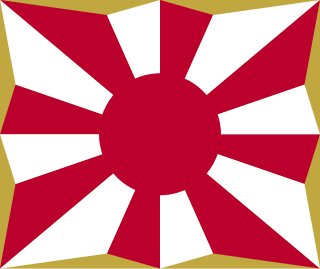
The Japan Self-Defense Forces, JSDF, also referred to as the Self-Defense Forces (SDF), Japan Defense Forces (JDF), or the Japanese Armed Forces, are the unified military forces of Japan that were established in 1954, and are controlled by the Ministry of Defense. The JSDF ranked as the world's fourth most-powerful military in conventional capabilities in a Credit Suisse report in 2015 and it has the world's eighth-largest military budget. In recent years they have been engaged in international peacekeeping operations including UN peacekeeping.



